More about Thimbles





Magdalena and William Isbister.
Westair Museum Reproductions, Birmingham
Westair Museum Reproductions produced several heavy pewter reproduction thimbles.
One such thimble had “Victoria - Albert 1840’ ‘engraved’ on a plain band around the thimble. The original thimble was made to commemorate the wedding of Queen Victoria and Prince Albert in 1840. The thimble was packaged in an explanatory plastic case (fig 50).
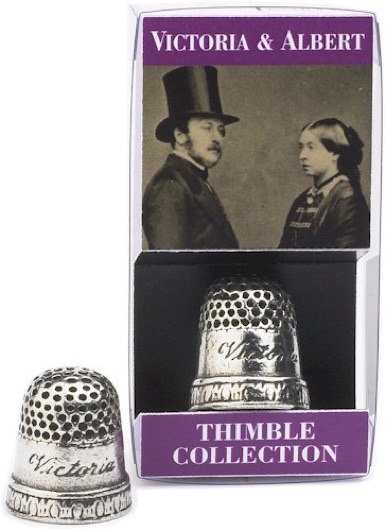
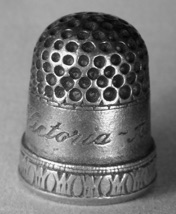
Fig 50
Several other Westair thimbles were similarly packaged (fig 51 -54).
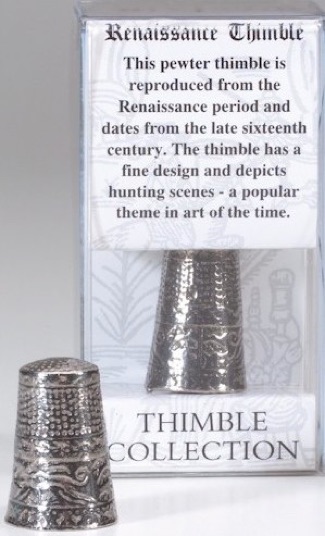
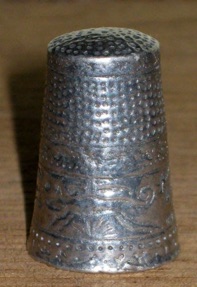
Fig 51
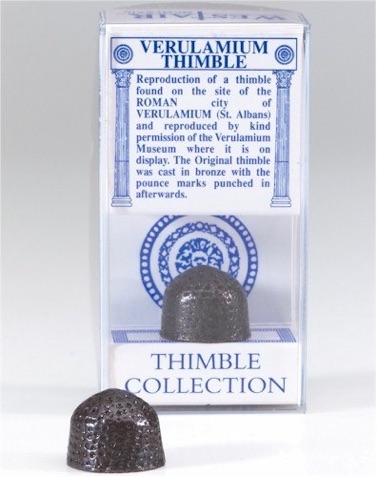
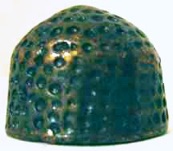
Fig 52
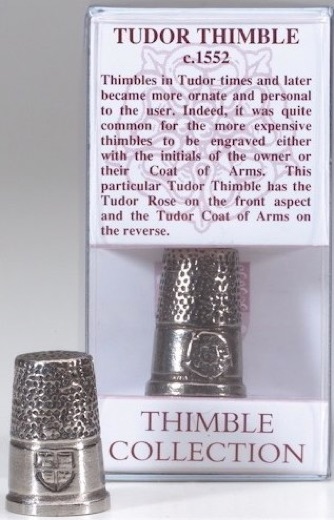
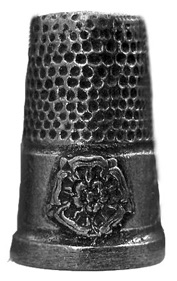
Fig 53
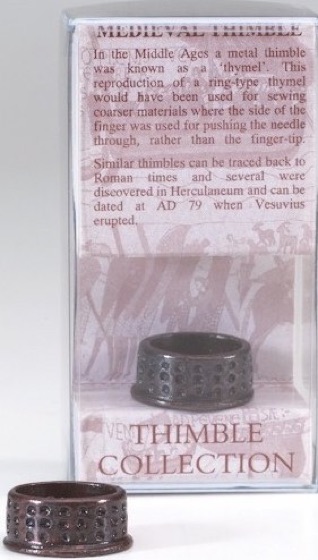
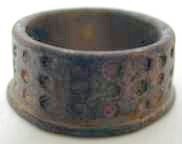
Fig 54
http://www.westair-reproductions.com/
Elfshot, St Johns, Newfoundland.
Tim Rast is a Canadian archaeologist and a flintknapper who specialises in artefact reproductions based on artefacts found across the Arctic and Subarctic, with an emphasis on Newfoundland and Labrador.

Fig 55
Rast has made an antiqued bone copy of an Eskimo thimble (fig 55). The original artefact is in the Canadian Museum of Civilization:
http://www.historymuseum.ca/home
http://elfshotgallery.blogspot.com/
Unknown
An unknown, possibly Asian, craftsman produced a series of engraved brass thimbles that were reproductions of English 17th century ‘Jacobean’ thimbles. The thimbles were made in two parts, like the originals, and had been ‘aged’ (fig 56).
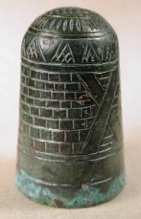
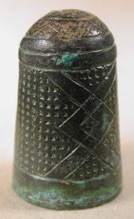
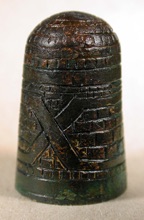
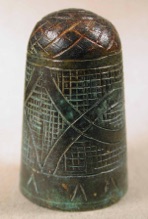
Fig 56
http://www.dugup.co.uk/index.htm

Fig 57
The maker of this brass replica of a 16c Nürnberg thimble complete with maker’s mark is unknown (fig 57). The maker’s mark and the height of the thimble distinguish it from the similar thimble made by Heirloom Editions Ltd (fig 32).

Fig 58
According to Zalkin (9) this thimble and two others were made in Israel by Antiquities of the Holy Land in Jerusalem but of the three thimbles illustrated by Zalkin, one seems to be a ‘Mary Rose’ replica (fig 41) and the other is identical to the one that was made by Heirloom Editions Ltd (fig 32). There must therefore be some uncertainty about the origin of this thimble too (fig 58).

Fig 59
An unknown maker made this silver reproduction of the Esther Willit thimble (fig 59). The original thimble was found at the Willit home site on Aquidneck Island, RI.


Fig 60
The ‘Jamestown Thimble’ (fig 60) is a reproduction of an early strap work brass thimble. It was cast in pewter and ‘antiqued’ to look like brass. The original thimble is on display in the museum at the Jamestown Visitor Centre.
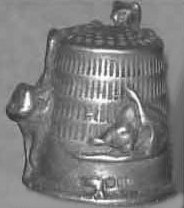
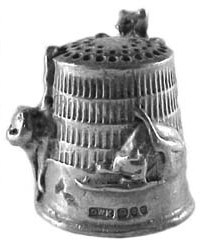
Fig 61
A cast reproduction (fig 61) by an unknown maker of a Kay Thetford Kendal –DWK –thimble. Both thimbles are cast but the reproduction (left) is clearly more crudely cast and finished.
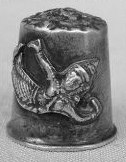
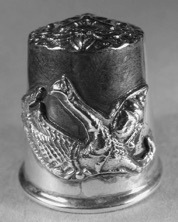
Fig 62
A cast reproduction of a Thai silver thimble (fig 62) is crude and has an everted rim. The original thimble (right) has a turnover rim and an applied ‘mermaid’.
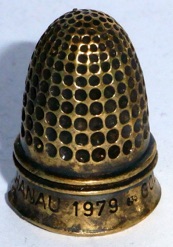
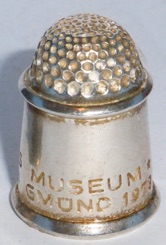
Fig 63
Two thimbles (fig 63), with Dutch markings (fig 64), by an unknown maker, possibly Sok Ung, according to von Hoelle (8), are reproductions of thimbles made originally to commemorate a thimble exhibition in Germany in 1978 (6). The original thimbles were made in limited numbers in both silver-gilt and gold.
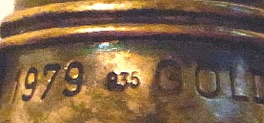
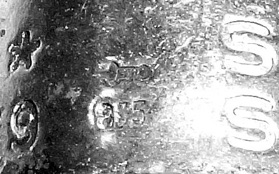
Fig 64
The thimbles illustrated in this section represent most of the commonly found reproduction thimbles available today but there are probably still many more circulating around the auctions by unknown makers?
It should be noted that some contemporary thimble makers make thimbles in historic styles but since they are not copies of specific thimbles they have not been included in this section. An example of this sort of work is a ‘Victorian’ finger guard made by the Reo Company (fig 65).

Fig 65
http://www.reocompany.com/product_info.php?products_id=2646
Re-issued thimbles
Re-issued thimbles are made with the original thimble dies but usually many years after the original thimble was made. The original dies may remain within the same company that made the original thimble (Simons Brothers Co.) or the original dies may have been acquired by a third party who is also a thimble maker (Thorvald Greif and Roger Lenain). The circumstances under which this may occur in practice are rare and presently we are only aware of three makers who have re-issued old thimbles.
Thorvald Greif, Creglingen, Germany
Helmut Greif took over the Gabler Brothers thimble factory in Schorndorf in 1964. In this way he obtained many of the Gabler thimble dies. Thorvald used some of the dies from his father and re-issued a few of the 19th century Gabler thimbles at the end of the 20th century.


Fig 66 Fig 67
One famous example is the ‘Busy Family’ - "Die fleissige Familie” from 1910 (No. 1099). It was originally designed by Prof. Christaller of Stuttgart. The re-issue is on the left (fig 66) and the original on the right (fig 67).
Orfèvrerie Lenain
When Roger Lenain purchased ‘Le Dé à Coudre’ in 1964 he obtained many of the original Lorillon/A Féau dies. Roger Lenain was interested in reviving the thimble making side of the company and in the 1970s, in conjunction with Mrs. Rosalind Belford of ‘Sewing Corner’ and later ‘Collectors Choice’ reissued the de la Fontaine Fable and other commemorative thimbles (10, 11) for the American market (fig 68 – 71).
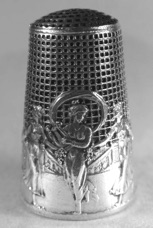
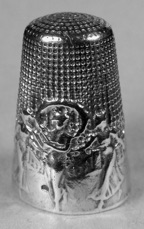
Fig 68
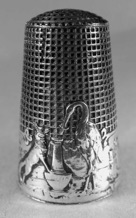
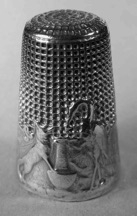
Fig 69

Fig 70
The ‘Dance of the Graces’ (fig 68), the ‘Fox and Stork’ (fig 69) and ‘Lovebirds’ (70) are included as examples. The re-issued thimble is on the left. A series of ‘Exposition thimbles’ (6) were also re-issued along with a thimble commemorating the First World War (fig 71).
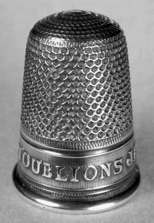
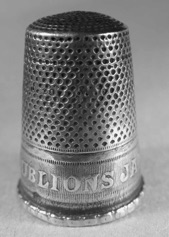
Fig 71
All of these thimbles have the same marks (11). The word ‘France’, a size number, the maker’s mark of Roger Lenain - it comprised the letters ‘L’ and ‘F’ separated by two interlaced ‘L’s, one reversed - and the Mercury head export mark signifying silver of a lower silver content (800).
Simons Brothers, Pa.
George Washington Simons started his business in 1839. Originally he was listed as a manufacturer of gold and silver thimbles and pencil cases. The company grew rapidly over the succeeding 20 years, expanding into manufacturing many other gold and silver items. Simons Brothers still use original dies to make some of their currently available thimbles (Fig 72 – 74). The reissued thimble is on the left in each thimble pair.

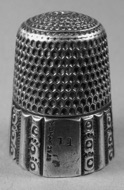

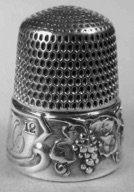
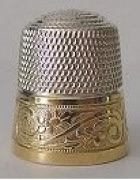
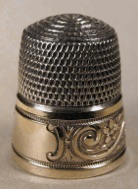
Fig 74

Fig 75
Made especially for the Smithsonian in 1984 was a gold-plated sterling silver thimble (fig 75). It is a re-issue of a thimble in the Mary Gallatin Hoppin Collection.
Re-issues are often listed as if they were original thimbles. All of the re-issues detailed above have at some time been listed as originals. The re-issues usually have fewer scratch marks indicating less use, are sometimes a little less well made and in the case of some of the French ones have a round turnover rim (fig 71).
Acknowledgements
We would like to thank Irene Schwall for permission to reproduce some of her images and Wolf-Dieter Scholz for help in identifying some of the thimble makers.
References
-
1.Holmes EF. A history of thimbles. London: Cornwall Books, 1985. pp. 220
-
2.Holmes EF. Thimble-RiggingThimble. Notes and Queries 1992; 15: 7.
-
3.Zalkin E. Zalkin’s Handbook of Thimbles & Sewing Implements, 1st ed. Willow Grove: Warman Publishing Co., Inc., 1985. pp. 243
-
4.Isbister M, Isbister W. Hybrid Thimbles. TCI Bulletin 2009; Winter: 1
-
5.Isbister M, Isbister W. Fabergé Thimbles. TCI Bulletin 2009; Summer: 1
-
6.Isbister M, Isbister W. Exposition Thimbles. TCI Bulletin 2010; Summer: 1
-
7.Plough G, et al. Hama, Fouilles et Recherches 1931- 1938 lV3. Copenhagen: Fondation Carlsberg, 1969. pp. 86.
-
8.von Hoelle JJ. Thimble collector’s encyclopedia. Illinois: Wallace-Homestead Book Company, 1986. pp. 134.
-
9.Zalkin E. Zalkin’s Handbook of Thimbles & Sewing Implements, 1st ed. Willow Grove: Warman Publishing Co., Inc., 1985. pp. 247, fig 31-8, fig 31-9, fig 31-10.
-
10.Belfford R. French Silver Thimbles. Silver, 1979: July-August: 34.
-
11.Isbister M, Isbister W. The ‘Merchants Warehouse’ Fable. TCI Bulletin 2007; Spring: 1
Holmes: ‘Thimble Rigging’ pp. 220.
Researched and published in 2002/11
Copyright@2011. All Rights Reserved
Magdalena and William Isbister, Moosbach, Germany
about ‘fakes’, reproductions and re-issues ii
Navigation
